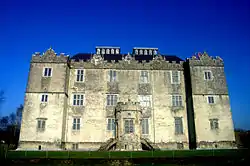Richard Burke, 4th Earl of Clanricarde
Richard Burke, 4th Earl of Clanricarde (also Richard de Burgh) (1572 – 12 November 1635) was an Irish nobleman and politician. He was the son of Ulick Burke, 3rd Earl of Clanricarde and Honora Burke. Knighted in 1602 for his exploits as leader of the English cavalry during the Battle of Kinsale, he would later serve as Governor of Connaught from 1604 to 1616, and as a member of the Privy Council of Ireland. Having established himself as the largest and most influential landowner in Connacht, his later life was characterized by animosity between him and an increasingly hostile and acquisitive Dublin government.
| Richard Burke (Richard de Burgh) | |
|---|---|
| 4th Earl of Clanricarde | |
| Reign | 1601–1635 |
| Predecessor | Ulick Burke, 3rd Earl of Clanricarde |
| Successor | Ulick Burke, 1st Marquess of Clanricarde |
| 1st Earl of St Albans | |
| Reign | 1628–1635 |
| Predecessor | Title Created |
| Successor | Ulick Burke, 1st Marquess of Clanricarde |
| 1st Baron of Somerhill | |
| Reign | 1624–1635 |
| Predecessor | Title Created |
| Successor | Ulick Burke, 1st Marquess of Clanricarde |
| Born | 1572 Galway, Ireland |
| Died | 12 November 1635 (aged 62–63) Galway, Ireland |
| Consort | Frances Walsingham (m.1603) |
| Issue | Ulick Burke Honora Burke Mary Burke |
| House | Clanricarde |
| Father | Ulick Burke |
| Mother | Honora Burke |
| Religion | Roman Catholic |
He actively served Queen Elizabeth I against the rebel Irish lordships and their Spanish allies during the Nine Years' War. He was appointed governor of Connaught, member of the privy council in Ireland, and, in 1624, created Viscount Tunbridge and Baron of Somerhill, a manor which he owned in Kent. The titles of Viscount Galway and Earl of St. Albans were conferred on him in 1628.

By 1633 he was not only one of the principal landowners in Ireland, but virtually all powerful in County Galway. This aroused the resentment of the Dublin Government, which decided to use the method of empanelling juries to "find" defective titles, in order to recover the lands in question for the English Crown. The treatment which Lord Clanricarde experienced from the Lord Deputy of Ireland, Thomas Wentworth, was said to have accelerated his death in November 1635: Wentworth however pointed to the Earl's advancing years as the obvious cause, and asked sarcastically if he was to blame for a man being over sixty. The feud, which was continued by Clanricarde's son and heir, was in the long run very damaging to Strafford, who apparently did not reflect on the close connections which Clanricarde, through his wife, had with just that faction of the English nobility, the Rich-Devereux clan, who were most hostile to Strafford.
In 1603, he married Frances Walsingham, the widow of Robert Devereux, 2nd Earl of Essex. They had one son, Ulick, and two daughters, Honora, who married John Paulet, 5th Marquis of Winchester, and Mary, wife of Hon. Edward Butler of Ballinahinch. He was succeeded by his son and heir, Ulick, as 5th Earl of Clanricarde, who in 1622 had married Lady Anne Compton, only daughter of William Compton, 1st Earl of Northampton.
References
- Lennon, Colm (2004), "Burke, Richard, fourth earl of Clanricarde", in Matthew, Henry Colin Gray.; Harrison, Brian (eds.), Oxford Dictionary of National Biography, 8, New York: Oxford University Press, p. 843, ISBN 0-19-861411-X
- Wedgwood, C.V. Thomas Wentworth 1st Earl of Strafford 1593-1641- a revaluation Phoenix Press reissue 2000
 This article incorporates text from a publication now in the public domain: "Burgh, Ulick de". Dictionary of National Biography. London: Smith, Elder & Co. 1885–1900.
This article incorporates text from a publication now in the public domain: "Burgh, Ulick de". Dictionary of National Biography. London: Smith, Elder & Co. 1885–1900.
| Government offices | ||
|---|---|---|
| Preceded by Unknown |
Lord President of Connaught 1604–1616 |
Succeeded by The Viscount Wilmot |
| Peerage of Ireland | ||
| Preceded by Ulick Burke |
Earl of Clanricarde 1601–1635 |
Succeeded by Ulick Burke |
| Peerage of England | ||
| New creation | Earl of St Albans 1628–1635 |
Succeeded by Ulick Burke |
| Viscount Tunbridge 1624–1635 | ||